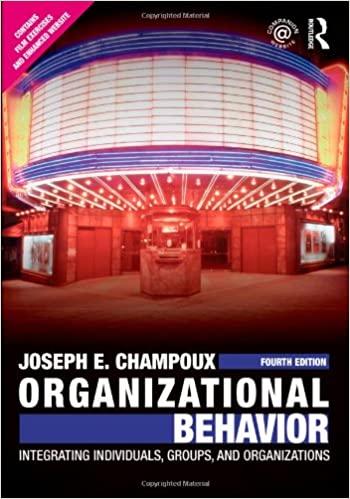Review the alternative views of leadership. How do those views differ from the other leadership theories? Why?
Question:
Review the alternative views of leadership. How do those views differ from the other leadership theories? Why?
ALTERNATIVE VIEWS OF LEADERSHIP
The next sections describe some alternative views of leadership that differ from those described so far in this chapter. Look for similarities and differences in what has already been said about leadership in organizations.
The Leadership Mystique
E. E. Jennings’s leadership mystique is a set of ideas, values, and beliefs that Jennings feels is the essence of leadership. The leadership mystique has three dimensions:
A sense of mission
A capacity for power
A will to survive and to persevere
A leader has a sense of mission—a vision of some future state for the organization. The vision is more than a strategic plan; rather, it is a dream about something that the leader wants to create. The result does not exist now, but it will exist. The mission becomes part of the heart, soul, and ego of the leader and is the leader’s heroic vision of the possible. A leader pursues that mission at great personal sacrifice and describes the mission with intense passion, trying to enlist others to pursue it also.
A capacity for power is the ability to get and use power to pursue the mission. Leaders have no fear of power, nor do they believe having power is undesirable. Power—and the capacity to get it—is basic to achieving the mission.
Leaders are often frustrated in their pursuit of their mission. They must have a will to survive and to persevere in reaching their mission. This third quality of the leadership mystique deals with impediments to achieving the mission— financial backers, competitors, government restrictions, and so on. A leader has “a will to persevere against a discourteous, unbelieving world of sometimes total opposition.”
Transformational Leadership
Transformational leadership emphasizes charisma, individualized consideration, and intellectual stimulation. Charisma is the most important part of transformational leadership because of the power it gives a leader. Followers of charismatic leaders trust them, identify with them, and have high confidence in them. Charismatic leaders often have high self-confidence, self-esteem, and self-determination.
Individualized consideration means the transformational leader recognizes variations in subordinates’ skills, abilities, and desires for growth opportunities. The transformational leader knows her subordinates well. The transformational leader also gives individual counseling, guidance, and support, and constructively critiques a subordinate’s performance. A key part of individualized consideration is the degree to which the leader shows genuine interest in subordinates.
Intellectual stimulation is the transformational leader’s ability to build high awareness of problems and solutions. Such leaders induce changes in the values and beliefs of subordinates. They stimulate subordinates to image new and different future states for the group. Intellectual stimulation is more than a change in present direction—it demands a large leap in the values, beliefs, and problem focus of subordinates.
Transformational leaders get their intellectual stimulation from superior technical ability and personal brilliance. They also create and manage symbols and images that represent their vision for the group or the organization. Emotional stimulation can be part of intellectual stimulation. The transformational leader imbues followers with a consciousness about some future state and each follower’s role in reaching that state.
Step by Step Answer:

Organizational Behavior Integrating Individuals Groups And Organizations
ISBN: 9780415804646
4th Edition
Authors: Joseph E. Champoux





